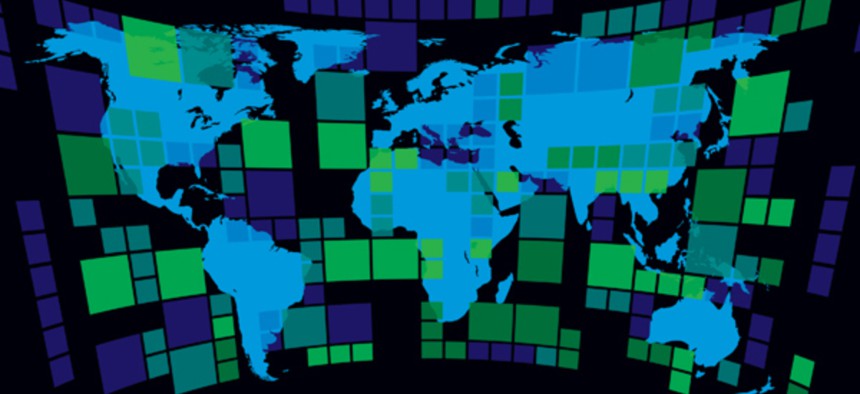What U.S. Intelligence Thought 2020 Would Look Like

Boguslaw Mazur/Shutterstock.com
A 2004 National Intelligence Council report was eerily prescient in some ways, and totally off in others.
In 2004, Mark Zuckerberg launched Facebook. George W. Bush was reelected president of the United States. And American intelligence analysts consulted with hundreds of experts across five continents to try to predict what the world would look like in 2020.
The result, a 119-page report by the National Intelligence Council titled “Mapping the Global Future,” is an eerie and illuminating read with 2020 now upon us. The authors, led by Mathew Burrows, then a top official at the council, sensed that the world was approaching an inflection point, even if they didn’t yet know what role the United States would play in it. “At no time since the formation of the Western alliance system in 1949 have the shape and nature of international alignments been in such a state of flux,” they wrote.
As with most expert predictions, the intelligence officials got plenty wrong about our present era. But they got a lot at least partially right, an indication that not everything about the world today is as unpredictable as it might seem. While the analysts at the National Intelligence Council may not have seen President Donald Trump coming 15 years ago, they anticipated Trumpism. They didn’t expect the United States to voluntarily reduce its presence in the world, but they grasped that its clout was eroding. They missed the Islamic State, but foresaw the conditions in which ISIS arose.
Here’s a rundown of the key things they got right, somewhat right, and totally wrong.
What They Got Right
- The unraveling of U.S. alliances: The fraying of America’s post–World War II alliances is often attributed to Trump’s rough treatment of traditional partners, but U.S. intelligence officials predicted the president’s underlying grievances. The report’s authors wrote that a trend to “bank on” was “dramatically altered alliances and relationships with Europe and Asia,” as European allies prioritized the European Union over NATO and Asian allies adjusted to the rise of China and India. The intelligence analysts predicted that by 2020, the United States would have to calculate the “acceptable cost” of maintaining alliances with European, Asian, and Middle Eastern countries no longer united by a common threat as they were during the Cold War. Trump’s answer has been that the current cost is way too high.
- An ascendant “America first” movement: In one scenario in the report, a fictitious United Nations secretary-general writes in her diary in September 2020 that “a lot of Americans are getting tired of playing the world’s policeman” and shouldering the burden of securing allies, convinced that Pax Americana is a rotten deal. (Yes, her: The UN chief, along with the American president, are depicted as women. The latter would have come true in 2016 if not for the Electoral College.) The UN leader notes that she is struggling to keep the UN headquarters in New York in part because there are “‘America Firster’ groups calling for the UN’s removal.” What the authors didn’t expect is that the American president himself would be an “America Firster.”
- The decline of international institutions: Foreshadowing the impotence of organizations such as the United Nations and the World Trade Organization in the face of climate change, trade wars, and other challenges, intelligence officials predicted that “some of the institutions that are charged with managing global problems may be overwhelmed by them” and that “such post-World War II creations as the United Nations and the international financial institutions risk sliding into obsolescence” unless they adapted to shifting global power dynamics. That adaptation never really happened.
- The impulse to make America great again: Intelligence analysts rightly anticipated that while the United States would remain the world’s preeminent power in 2020, Americans would see their country’s influence diminish relative to emerging powers. In other words, they envisioned at least one dimension of the coming anxiety about making America great again, if not the slogan itself. In 2004, this observation about the relative diminution of the United States was considered one of the report’s most heretical findings. As Fred Kaplan inquired in Slate after the study was released, “Who will be the first politician brave enough to declare publicly that the United States is a declining power?”
- Escalating competition between the U.S. and China: American intelligence officials didn’t envision the trade war or the Washington buzzword of great-power competition, but the report’s authors predicted that “rising nationalism in China and fears in the U.S. of China as an emerging strategic competitor could fuel an increasingly antagonistic relationship.” And they presciently pointed to the ripple effects, noting that the United States would have to design a vision of “security and order” in Asia to rival China—what Trump has sought to do with his Indo-Pacific Strategy—and that countries such as Japan would feel compelled to “choose between ‘balancing’ against or ‘bandwagoning’ with China.” So far, Tokyo has picked balancing.
- The North Korean nuclear crisis: Writing before North Korea tested its first nuclear weapon, intelligence officials foresaw that “the crisis over North Korea” would “come to a head sometime over the next 15 years.” They predicted that it would involve Pyongyang developing nuclear-capable missiles that could reach the United States “well before 2020,” deterring the U.S. from using military force against the country and prompting America’s allies in the region to consider developing their own nuclear weapons. These are the very factors that led Trump to first threaten war and then pivot to diplomacy with Kim Jong Un.
What They Got Partially Right
- The populist backlash to globalization, but not in the West: The report’s authors thought that “charismatic, self-styled populist leaders” playing “on popular concerns over inequities between ‘haves’ and ‘have-nots’” would “emerge as a potent political and social force” in reaction to the dislocations of globalization. But they thought these figures would primarily arise in developing countries in Latin America and Asia, not in advanced democracies such as the United States and the United Kingdom.
- The declaration of a caliphate, but not by a terrorist group: The analysts forecasted that al-Qaeda, the dominant jihadist group in 2004, would be eclipsed by more decentralized groups that used the internet to reach alienated young Muslims. They even posited one scenario that must have seemed outlandish at the time: the declaration of a new caliphate that gains traction online and in ungoverned spaces in the Muslim world, attracting pledges of allegiance from followers ranging from Olympic athletes to an American senator’s daughter. But the report’s authors didn’t foresee a terrorist group like ISIS establishing the Islamic state—instead, they imagined it being founded by a young preacher moderate enough to elicit outreach from the pope.
- The ascent of China and India, but not enough emphasis on China: Intelligence officials described the rapid rise of China and India as twin phenomena, noting that these developments “would transform the geopolitical landscape” in a manner reminiscent of “the advent of a united Germany in the 19th century and a powerful United States in the early 20th century.” The report’s authors accurately forecasted the economic and population growth of both emerging powers, but they missed the fact that it would be China’s rise far more than India’s that would define international affairs heading into 2020.
What They Got Wrong
- A clash between the U.S. and China over the political status of Taiwan: The intelligence officials sketched out one scenario involving a military confrontation between China and Taiwan over a Taiwanese proclamation of independence, which would likely draw in the United States as Taiwan’s top ally. That hasn’t happened—well, at least not yet.
- The establishment of a Palestinian state: The report refers (if rather obscurely) to a sovereign state of Palestine, with Jerusalem as a city shared by Israelis and Palestinians. Such an outcome has arguably never seemed more remote than it does today, despite the fact that the Trump administration claims to still be working on a peace plan.
- Russia as a down-and-out power: Intelligence officials didn’t foresee the systematic challenge Russia would pose to the West, arguing that the country’s demographic and public-health challenges would “limit the extent to which Russia can be a major global player.” They failed to envision Russia’s interference in U.S. and European elections, and its invasion of Ukraine, noting that “the prospect of Moscow reasserting control” over former Soviet states “seems improbable.” The analysts did, however, recognize that Vladimir Putin was stoking nationalism, and that his “successors” would persist in tapping into nostalgia for Russia’s imperialist past. Imagine the authors’ surprise when they learned that Putin himself would still be the Russian leader carrying out this effort in 2020.
- The inevitability of globalization: The study’s authors recognized that catastrophic events such as a pandemic or major terrorist attack could slow or stop globalization, but they generally wrote about growing interconnectedness as irreversible. They characterized globalization as “a force so ubiquitous that it will substantially shape all the other major trends in the world of 2020.” At the onset of the new year, it’s clear that global interconnectedness is far more vulnerable to being reversed than U.S. intelligence officials thought a decade and a half ago.
NEXT STORY: FAS won't ditch pricing tools






